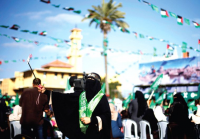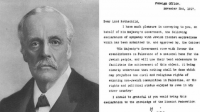
The email photos and text. Source: TheAustralian

Sonja Karkar. Source: Supplied
THE activist group Australians for Palestine has prompted outrage by misrepresenting an image of children killed in Syria as young victims of the conflict in Gaza in an email to MPs that attacked Israel’s operations.
The group, whose August 10 email compared those killed in Gaza to victims of the Holocaust, has declined to correct the error or apologise, even after the deceptive use of the image was exposed.
Underneath the image of dead children, Australians for Palestine editor Sonja Karkar wrote that “some people may find the above photo disturbing and we hope it is”.
“It is not being shown gratuitously, but to bring home the true awfulness of what is happening in Gaza,” she wrote.
The email continued: “Almost 2000 Palestinians have been slaughtered and some 10,000 Palestinians have been wounded ... Israel’s bombs continue to strike with vengeance at the civilian population below. Make no mistake about it: more than 80 per cent of those already killed were civilians.
“We cannot shed tears over yesteryear’s Holocaust victims when reading books, seeing films or visiting museums and not see that these innocent Palestinian children today are just as deserving of your sorrow and outrage.”
Liberal MP Luke Simpkins told The Australian he believed he had seen the photo before. The former long-serving army officer raised the picture’s provenance with Ms Karkar.
Mr Simpkins discovered the same image had appeared in a Canadian online news site in May this year and an Israeli website last November, well before the current fighting in Gaza began early last month.
On August 12, Ms Karkar told Mr Simpkins: “Since sending out this email I have been alerted to the fact that this picture was taken in Syria and not Gaza. It was a careless error to make on my part.”
She continued: “In my next post I will be apologising for using the wrong image.”
The following Australians for Palestine email bulletin, dated August 18, made no mention of the matter.
Ms Karkar did not respond to requests for comment yesterday.
Another key Australians for Palestine figure, Nasser Mashni, declined to speak to The Australian, but Mr Simpkins lashed the group.
“Given that the AFP calls for outrage, I can say that I was outraged at their abuse of the facts and taking advantage of the deaths of innocent Syrian children in the biggest, most desperate conflict and human tragedy in the region,” he said.
“I find their ethics and tactics deplorable in their attempt to win favour with the Australian people.”
Mr Simpkins said there was no comparison between the civil war in Syria, unfolding events in Iraq and the most recent round of action in Gaza targeting Hamas.
“Hamas is a terrorist organisation that uses public television to encourage and indoctrinate children to aspire to kill Jewish people,” he said. “For years Hamas have fired rockets into Israeli suburbs and towns, all from civilian areas. They are cowards that hide behind innocent people.”
Allegations that confronting images of conflict in the Middle East found on social media or the internet are staged, mislabelled or misattributed have become so widespread a derogatory name has been coined for them — Pallywood, a contraction of Palestine and Hollywood.
Despite the mocking title, Jewish leaders around the world are deeply concerned by the proliferation of the pictures. There are fears the images are licensing anti-Semitism and provoking violence and abuse directed at their communities.
Jeremy Jones from the Australia/Israel & Jewish Affairs Council said graphic images “which are purportedly from Gaza which have later been authoritatively identified as coming from Syria, Iraq or Egypt, proliferate on social media”.
“In addition, photographs which have been shown to be staged and images which have been manipulated for dramatic effect spread virally through Facebook and Twitter,” he said.
Mr Jones warned against the abuse of photographs.
“Individuals and organisations which want to be treated as serious contributors to policy development need to exercise as much caution with images as they do with text,” he said. “To distribute an inaccurately labelled image, which is not only unverified but which could have been easily identified, is as bad as circulating outright errors of fact.”
Mr Jones hit out at Australians for Palestine over the episode.
“In this situation, the image was challenged, but when the person distributing it admitted it was not from Gaza she did not honour a commitment to publicise and correct the error,” he said. “It would appear that bad judgment was supplemented by bad faith.”
A wave of anti-Semitic incidents has occurred since the outbreak of fighting in Gaza last month.
In the most recent incident, anti-Semitic flyers saying “Wake up white Australia” were distributed in Bondi, in Sydney’s eastern suburbs.






















